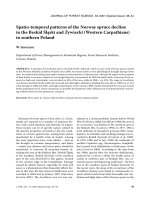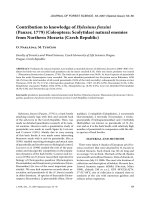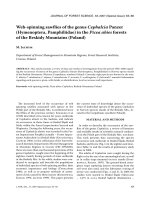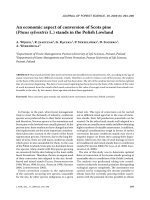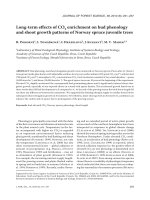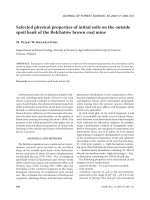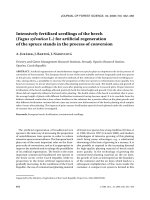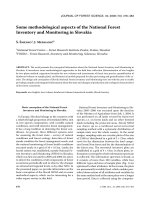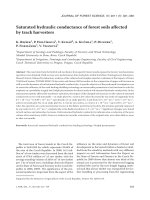Báo cáo lâm nghiệp: "Intensively fertilised seedlings of the beech (Fagus sylvatica L.) for artificial regeneration of the spruce stands in the process of conversion" pdf
Bạn đang xem bản rút gọn của tài liệu. Xem và tải ngay bản đầy đủ của tài liệu tại đây (446.17 KB, 7 trang )
452 J. FOR. SCI., 54, 2008 (10): 452–458
JOURNAL OF FOREST SCIENCE, 54, 2008 (10): 452–458
The artificial regeneration of broadleaved tree
species is the main way of increasing the proportion
of autochthonous trees species in order to reduce
extensive spruce monocultures. e European beech
plays one of the most important roles on the Euro-
pean scale of conversions, and so it is appropriate to
improve the methods and to enlarge the possibilities
of its artificial regeneration. e beech is the most
important commercial broadleaved tree species in
the forest sector of the Czech Republic while its
proportion in the forest artificial regeneration is
gradually increasing. In the conditions of the Czech
Republic, the use of containerised planting material
of forest tree species has a long tradition (D et
al. 1985; M 1997; J 2000), and modern
technologies of intensive growing of this planting
stock bring many advantages, e.g. a substantial
shortening of the time of growing in a nursery. It is
also possible to respond to the increasing demand
for high-quality planting material of beech much
more quickly. In the technology of growing the
containerised planting material on the air layer,
the growth of roots is interrupted on the boundary
of the container and the air layer, which leads to a
subsequent multiplication of fine roots inside the
container. A compact root system is formed in this
Supported by the Ministry of Agriculture of the Czech Republic, Project No. MZe 0002070201.
Intensively fertilised seedlings of the beech
(Fagus sylvatica L.) for artificial regeneration
of the spruce stands in the process of conversion
A. J, J. B, J. N
Forestry and Game Management Research Institute, Strnady, Opočno Research Station,
Opočno, Czech Republic
ABSTRACT: Artificial regeneration of autochthonous target tree species plays an important role in the process of
conversion of forest stands. e European beech is one of the most suitable and most frequently used tree species
in this process. Modern technologies of intensive methods of the cultivation of the European beech seedlings pro-
vide, among others, a possibility to increase the proportion of this tree species in reforestation more quickly. It is
however necessary to test at what types of sites this planting material can be used. e health status and growth of
intensively grown beech seedlings in the first years after planting were studied on 2 research plots. Proper intensive
fertilisation of the beech seedlings affected positively both the initial height and growth. Even the slow-release fer-
tiliser did not negatively influence the beech after planting. e health status of the beech is excellent after 4 years,
the average height of plants with different fertilisation treatments having become equal. It is to conclude from the
hitherto obtained results that a slow-release fertiliser in the substrate has a positive effect on the plant growth, and
that different fertilisation variants did not cause any serious root deformations of the beech planting stock samples
taken 4 years after planting. e impacts of prior nursery fertilisation upon the beech planted under the conditions
of extreme sites are further investigated.
Keywords: European beech; fertilisation; containerised seedlings
J. FOR. SCI., 54, 2008 (10): 452–458 453
way that is disposed to grow well after planting onto
permanent sites because the higher proportion of
fine roots in this technology is a very positive feature
from the aspect of plant survival (N 2003;
N 2003). e European beech is a tree
species exploiting the intensive growth environment
of nursery operations (J 2000). In the system
of testing the biological safety of containers for the
containerised planting material of the beech, 11 ty-
pes of containers were recommended in the Czech
Republic (J et al. 2006). e paper presents
the results of the morphological parameters of the
European beech four years after reforestation of
sites of different types when beech seedlings were
produced in three variants of fertilisation dose. One
of the longer-term objectives of these experiments
is to assess whether the intensive fertilisation of this
planting material will have any negative effects on
the growth and health states after the young trees
have been planted into forest stands.
MATERIAL AND METHODS
An intensive nursery technology was used to
grow one-year-old seedlings of the European beech.
HIKO V 265 containers (cells 15 cm high, upper
edge 4.8 cm long, density 368 cells per 1 m
2
) were
filled with the substrate at three levels of fertilisa-
tion using Osmocote (main nutrients – N 15%, P
2
O
5
10%, K
2
O 10%, MgO 3% including other microele-
ments): treatment A – a recommended dose of the
slow release fertiliser in the substrate (hereinafter
“normal fertilisation into the substrate”), treatment
B – luxury fertilisation of the substrate with a two-
fold dose of the slow-release fertiliser (hereinafter
“luxury additional fertilisation of the substrate”),
treatment C – the growth substrate was not ferti-
lised, only foliar nutrition (Wuxal-super fertiliser in
0.2% strength contains: total nitrogen 8%, P
2
O
5
8%,
K
2
O 6% including trace elements B, Fe, Cu, Mn, Mo
and Zn) was applied during the growth season at
a recommended dose (hereinafter “control – foliar
nutrition only”). Fertilisers with different periods of
nutrient release were applied within the framework
of these main treatments (final substrate resulted
from a thorough mixing of peat, inert bulk matter,
and fertiliser); more detailed specification of these
subtreatments is given in Table 1. e planting of
one-year-old seedlings of the European beech onto
the experimental plots was carried out in the autumn
season, onto two experimental plots. e localities
Trutnov (560 m above sea level, SLT 5K beech with
fir on acidic site) and Zlaté hory (650 m a.s.l., SLT
5S beech with fir on nutrient-medium site) are cli-
matically optimal for the European beech growth.
Prior to planting, soil samples were taken from both
localities to be analysed in a laboratory. e samples
were analysed for pH (both H
2
O and KCl), nitrogen
(Kjeldahl), and plant-available nutrients (P, K, Ca,
Mg). Neither extreme values nor nutrient deficiency
was found in the soil samples. At least 500 trees were
planted per treatment. Morphological parameters
(height growth and root collar diameter) of these
plantations and their health state were investigated
every year. Ten samples of all variants were taken
from both research plots in 2007. e samples were
analysed in FGMRI laboratory in order to reveal root
deformations in accordance to the valid standards of
planting stock quality (ČSN 48 2215, 1998).
e data were statistically analysed using ANOVA
for MS Excel and Bonferroni Multiple-Comparison
Test (with control) which is a statistical tool in NCSS
Table 1. An overview of fertilisation treatments for growing one-year-old plantable seedlings of the European beech
Main treatments Planting site Treatments
Fertiliser used
in nursery
Fertiliser dosage
(kg/m
3
)
Recommended dose of fertiliser in substrate
Trutnov,
OS 12/4
Osmocote
4
Zlaté hory 12–14 months*
Trutnov,
OS 3/2
Osmocote
2
Zlaté hory 3–4 months
Luxury dose of fertiliser in substrate
Trutnov,
OS 12/8
Osmocote
8
Zlaté hory 12–14 months
Trutnov,
OS 3/4
Osmocote
4
Zlaté hory 3–4 months
No fertiliser in substrate
Trutnov,
Control
Foliar nutrition
(Wuxal)
–
Zlaté hory
*e time of nutrient release declared by the manufacturer
454 J. FOR. SCI., 54, 2008 (10): 452–458
software. Error bars in Figs. 1 and 2 depict the con-
fidence intervals (P = 0.05).
RESULTS AND DISCUSSION
e impact of the fertilisation treatments on the
growth of the European beech was studied on 2 re
-
search plots under favourable growth conditions of
beech natural range. It was a common feature for
both research plots that the seedlings fertilised into
the substrate had statistically significantly larger
height and root collar diameter compared to the
control with foliar nutrition (Table 2).
On the research plot Zlaté hory, a good health
state had been observed since the establishment. e
highest proportion of losses was due to the damage
caused by murines, but total losses did not exceed
5%. In the first year after planting, relatively great
differences between the treatments were found out
in the damage or withering of terminal shoots of
the planting material (Table 3). In the first year after
reforestation, the lowest occurrence of such damage
was recorded in the control treatment C (with foliar
nutrition only), the highest in the treatments using
the application of fertilisers with a shorter period
of nutrient release. In the second year after plant-
ing, the occurrence of terminal shoots damage was
minimal. It was the highest in the treatments where
the slow-release fertiliser with a longer period of
nutrient release had been applied. e presented
results document the persistence of the effects of
fertilisation in the nursery in the 1
st
and partly in
the 2
nd
year after planting. Similarly, e.g. W
and H (1994) reported that large broadleaved
seedlings grown with the application of high doses
of fertilisers often had soft tissues and other unsuit-
able characteristics that could have adverse effects
on their development after planting. e need of
Height growth – Zlaté hory
0
20
40
60
80
100
120
140
OS 12/4 OS 3/2 OS 12/8 OS 3/4 Control
Treatment
cm
Initial 1st YR 2nd YR
3rd YR 4th YR
Height growth - Trutnov
0
20
40
60
80
100
120
140
OS 12/4 OS 3/2 OS 12/8 OS 3/4 Control
Treatment
Initial 1st YR 2nd YR
3rd YR 4th YR
Root collar diameter – Trutnov
0
5
10
15
20
OS 12/4 OS 3/2 OS 12/8 OS 3/4 Control
Treatment
mm
Initial 1st YR 2nd YR
3rd YR 4th YR
Root collar diameter – Zlaté hory
0
5
10
15
20
OS 12/4 OS 3/2 OS 12/8 OS 3/4 Control
Treatment
mm
Initial 1st YR 2nd YR
3rd YR 4th YR
Fig. 1. e height growth of European beech plants with different fertilisation treatments on research plots Zlaté hory and
Trutnov. For the description of treatments see Table 1. Vertical bars demonstrate intervals of confidence of total height
Fig. 2. Root collar diameter of European beech plants with different fertilisation treatments in the particular years after planting
onto Zlaté hory and Trutnov research plots. For the description of treatments see Table 1. Vertical bars demonstrate intervals
of confidence of total collar diameter
(cm)
(cm)
(mm)
(mm)
–
1
st
YR
4
th
YR3
rd
YR
2
nd
YR
1
st
YR
4
th
YR
3
rd
YR
2
nd
YR
1
st
YR
4
th
YR
3
rd
YR
2
nd
YR
1
st
YR
4
th
YR3
rd
YR
2
nd
YR
J. FOR. SCI., 54, 2008 (10): 452–458 455
Table 2. Morphological features of the subtreatments of the European beech seedlings before planting to regeneration
experimental plots. e description of treatments see in Table 1. In the columns, the values followed by different letters
are significantly different (P = 0.05)
Treatment Height (cm)
Root collar diameter
(mm)
Root/above ground dry
matter ratio
Root
deformation
(%)
OS 12/4
x 38.6b 4.7bc 99.0c 0
Sx 9.52 0.74 0.30
n 100 100 100
OS 3/2
x 43.7c 5.0bc 96.6c 1
Sx 11.21 0.86 0.31
n 100 100 100
OS 12/8
x 44.4c 4.6b 79.3b 1
Sx 11.94 0.79 0.28
n 100 100 100
OS 3/4
x 45.4c 5.0c 62.3a 1
Sx 10.27 0.81 0.23
n 100 100 100
Control
x 19.7a 3.8a 160.6d 0
Sx 3.16 0.49 0.61
n 100 100 100
Fig. 3. 4-year-old individuals from Zlaté hory research plot. Left – root system developed under conditions of luxury Osmocote
dose, right – control
456 J. FOR. SCI., 54, 2008 (10): 452–458
balanced nutrition for a good survival and resist-
ance was accentuated by B (1994), A
and M (1994), G (1996), P (1996),
and L (2006). M and P (2004)
also pointed to the risk of the root deformations as
a result of inappropriate fertilisation.
e highest relative increment in two years after
planting occurred in the control treatment. The
height growth (Fig. 1) of this treatment was posi-
tively influenced by the lower occurrence of with-
ered terminal shoots that were more frequent in
the treatments using fertilisation into the substrate.
After four years of growth the height differences
between the treatments applying the slow-release
fertiliser and the control (foliar nutrition) were
gradually equalised on both plots even though they
have remained statistically highly significant until
now (except Trutnov OS 3/4 and Control). Four
years after planting the control variant was statisti-
cally different from the fertilised variants OS 12/4,
OS 3/2 and OS 2/8. is is an indirect proof that the
slow-release fertiliser had been already consumed
and the roots should spread freely outside the root
ball. An important finding is that four years after
planting the beech plants of all treatment variants
including the control satisfy the criteria of an estab-
lished plantation.
At the time of planting, i.e. after growing in the
nursery, the planting material with the application
of a slow-release fertiliser into the substrate had
significantly larger root collar diameter compared to
the control, i.e. to the plants that had received only
foliar nutrition in the nursery. e evaluation of the
diameter increments in the planting experiments is
shown in Fig. 2. No significant differences occurred
in the collar diameter on the plot Zlaté hory (Table 4).
On the plot Trutnov, the collar diameters in the vari-
ants of fertilisation treatment OS 12/4, OS 3/2, and
OS 12/8 differ significantly from the control.
Table 3. Percentage of damage occurrence of terminal
shoots during 1
st
and 2
nd
years after outplanting on the plot
Zlaté hory. e description of treatments see in Table 1
Treatment
Damage frequency
1
st
year (%) 2
nd
year (%)
OS 12/4 9.7 1.4
OS 3/2 16.3 0.5
OS 12/8 11.0 2.2
OS 3/4 14.2 0.2
Control 3.1 0.2
Table 4. Above-ground height, root collar diameter, and number of root deformations in the variants of fertilised beech
planting stock in 4
th
year after planting on both plots Zlaté hory and Trutnov. In the columns, the values followed by
different letters are significantly different (P = 0.05)
Locality Zlaté hory Trutnov
Treatment
height
(cm)
root collar
diameter (mm)
root
deformation
(%)
height
(cm)
root collar
diameter (mm)
root
deformation
(%)
OS 12/4
x 117.50ab 18.30a 119.90ab 16.60b
Sx 35.24 4.38 31.93 3.48
n 298.00 123.00 0 101.00 101.00 1
OS 3/2
x 124.70b 19.00a 117.70ab 16.50b
Sx 38.92 4.61 28.77 2.95
n 309.00 128.00 2 100.00 100.00 0
OS 12/8
x 122.50b 18.20a 128.00b 18.60b
Sx 34.96 4.57 30.24 3.40
n 359.00 116.00 1 100.00 100.00 2
OS 3/4
x 122.70b 17.60a 110.40a 16.20ab
Sx 35.40 4.67 32.49 3.29
n 432.00 128.00 2 100.00 100.00 0
Control
x 110.80a 17.30a 107.40a 14.80a
Sx 38.28 4.19 29.72 2.80
n 370.00 106.00 4 100.00 100.00 0
J. FOR. SCI., 54, 2008 (10): 452–458 457
Different-dose Osmocote fertilisation did not re-
sult in significantly increased number of root defor-
mations (8 occurrences) compared to foliar nutrition
control (4 occurrences). Moreover, no serious defor-
mation affecting the stability of the beech plants was
found (Fig. 3). To verify the further development,
the analysis of the root samples will be repeated in
the next years.
CONCLUSIONS
e results of the investigation of the intensively
grown planting stock of the beech with different
fertilisation treatments, growing under relatively
optimum conditions, document that:
– only minimum losses were recorded (max. 5%)
with all experimental treatments,
– the intensively fertilised greenhouse planting
stock (plugs) can be used for artificial regeneration
of plots with favourable growth condition without
negative impacts on its survival and growth in the
first years after planting,
– in spite of marked morphological differences
between the plants fertilised into the substrate
and those of the control treatment (application
of foliar nutrition only), they all achieved the
parameters of established plantation in the same
time interval (in 4
th
year after planting),
– the equalisation of average heights of the beech
plants that obtained different fertilisation treat-
ments indicates that the slow-release fertiliser has
been already consumed and the roots can spread
freely outside the root ball,
– different variants of fertilisation did not cause any
serious root deformations of the beech planting
stock samples taken in 4
th
year after planting,
therefore the stability of plantation is not threaten-
ed. Neither the substrate-fertilised stock nor the
foliar-fertilised one differed in terms of the root
deformation frequency.
In other parallel experiments, the impact of in-
tensive nursery fertilisation on the establishment
of beech plantations in extreme growth conditions
is studied. The results will be known in the next
years.
R efer e nces
ALDHOUS J.R., MASON W.L., 1994. Forest Nursery Prac-
tice. Forestry Commission Bulletin, 111. London, HMSO:
268.
BARNES H.W., 1994. Fertilizers: interactions and overwin-
tering – a review. International Plant Propagators’ Society,
Combined Proceedings, 43: 475–479.
DUŠEK V., MARTINCOVÁ J., JURÁSEK A., 1985. Zvýšení
kvality obalené sadby. Jíloviště-Strnady, VÚLHM – VS
Opočno: 6.
GRASSI G., 1996. Influenza della luce e del substrato sullo
sviluppo di semenzali di fagio (Fagus sylvatica). Monti e
Boschi, 47: 54–62.
JURÁSEK A., 2000. Vliv kvality obalené sadby na zdravotní
stav výsadeb v horských podmínkách. In: S
LODIČÁK M.
(ed.), Lesnické hospodaření v imisní oblasti Orlických
hor. Sborník referátů z celostátního semináře, Opočno,
31. 8.–1. 9. 2000. Opočno, VÚLHM – Výzkumná stanice:
161–163.
JURÁSEK A., NÁROVCOVÁ J., NÁROVEC V., 2006.
Průvodce krytokořenným sadebním materiálem lesních
dřevin. Kostelec nad Černými lesy, Lesnická práce: 56.
LIBUS J., 2006. Vliv přehnojení dusíkem a hořčíkem na růst
sadebního materiálu buku lesního a smrku ztepilého.
/>ni_N_Mg.pdf: 59.
MAUER O., 1997. Kvalita služeb školkařských provozů. Zprávy
lesnického výzkumu, 42: 17–18.
MAUER O., PALÁTOVÁ E., 2004. Deformace kořenového sys-
tému a stabilita lesních porostů. In: Možnosti použití sadeb-
ního materiálu z intenzivních školkařských technologií pro
obnovu lesa. Sborník přednášek z mezinárodního semináře,
Opočno, 3.–4. 6. 2004. Kostelec nad Černými lesy, Lesnická
práce: 22–26.
NÁROVEC V., 2003. 100× über die Düngung im Wald. Ko-
stelec nad Černými lesy, Lesnická práce: 31.
NÁROVCOVÁ J., 2003. Úloha akreditované laboratoře
školkařská kontrola při ověřování biologické vhodnos-
ti obalů krytokořenného sadebního materiálu lesních
dřevin: některé zkušenosti s kvalitou kořenových soustav
testovaných technologií. In: Perspektivy pěstování
krytokořenného sadebního materiálu v podmínkách
České republiky po vstupu do EU. Dlouhá Loučka, 3. 9.
2003: l.
PRASAD M., 1996. Nutrient survey of nursery stock in Ireland
and U. K. including nutrient reserve analysis in controlled-
release fertiliser and leaf analysis. International Plant Propa-
gators’ Society, Combined Proceedings, 46: 183–189.
WILLIAMS R.D., HANKS S.H., 1994. Hardwood Nursery
Guide. Agriculture Handbook No. 473. Washington, U.S.
Department of Agriculture: 78.
ČSN 48 2115, 1998. Sadební materiál lesních dřevin. Praha,
Český normalizační institut: 17.
Received for publication May 2, 2008
Accepted after corrections July 24, 2008
458 J. FOR. SCI., 54, 2008 (10): 452–458
Corresponding author:
Doc. Ing. A J, CSc., Výzkumný ústav lesního hospodářství a myslivosti, v.v.i., Strnady,
Výzkumná stanice Opočno, Na Olivě 550, 517 73 Opočno, Česká republika
tel.: + 420 494 668 391, fax: + 420 494 668 393, e-mail:
Využití intenzivně hnojeného sadebního materiálu buku lesního
při přeměnách smrkových monokultur
ABSTRAKT: Umělá obnova původních cílových druhů dřevin má důležitou úlohu v procesu přeměny lesních porostů.
Jednou z nejdůležitějších a nejčastěji používaných dřevin v tomto procesu je buk lesní. Moderní technologie intenziv
-
ních postupů pěstování krytokořenného sadebního materiálu buku lesního přinášejí mimo jiné možnost rychlejšího
zvyšování podílu této dřeviny při umělé obnově lesa. Je ale třeba ověřit, na jakých typech stanovišť je možné tento
sadební materiál použít. Zdravotní stav a růst intenzivně pěstovaného sadebního materiálu buku v prvních letech
po výsadbě byl sledován na dvou lokalitách s relativně optimálními růstovými podmínkami. Vyvážené intenzivní
hnojení semenáčků buku lesního ve školce pozitivně ovlivnilo jejich velikost v době výsadby i následný růst. V pod
-
mínkách příznivých pro růst buku nemělo intenzivní hnojení dlouhodobější negativní účinky na odolnost k nepří
-
znivým klimatickým vlivům, působícím po výsadbě, a to ani v případě použití hnojiv s dlouhou dobou uvolňování
živin. Buk vykazuje po čtyřech letech růstu výborný zdravotní stav a na relativně příznivém stanovišti pro buk došlo
téměř k vyrovnání průměrné výšky rostlin u různě hnojených variant. Ze získaných výsledků vyplývá, že pěstování
sadebního materiálu buku s přidáváním pomalu rozpustných hnojiv do substrátu má pozitivní vliv na růst. Různý
způsob hnojení krytokořenných semenáčků buku ve školce neměl negativní efekt na tvorbu závažných kořenových
deformací kořenového systému čtyři roky po výsadbě. Možné dopady použití různých způsobů hnojení ve školce na
růst sadebního materiálu buku na extrémnějších stanovištích jsou v současnosti předmětem výzkumu.
Klíčová slova: buk lesní; hnojení; krytokořenný sadební materiál

